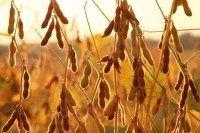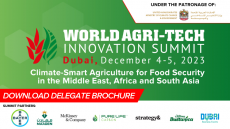Special edition: Organic & non-GMO
The biggest fallacy about GMOs is that we need them to feed the world: WFP

“The biggest misconception in our industry when it comes to GMOs is that we need them to feed the world,” Tyler Lorenzen, World Food’s director and vice president of business development, told FoodNavigator-USA. “GMOs may be one tool to do that, but I do think plant-based proteins have a huge future in non-GMO, alternative protein sources to help feed the world sustainably. Organic, non-GMO pea and soy protein will play a large role in that.”
Lorenzen’s parents Jerry and Renee Lorenzen started Oskaloosa, IA-based World Food Processing in 1985, five years before the Organic Foods Production Act defined standards for organic farming practices in the US, back when soybeans were primarily seen as animal feed.
Shift to plant protein a ‘natural progression’ in the human diet
“When we started, viewing soybeans as human protein rather than for animal feed was a bit unheard of,” Lorenzen said. “But the way the population has grown and protein needs alongside that, eating just animals is not a model that works.”
Plant proteins in general have steadily grown over the past 15 to 20 years, which Lorenzen attributes to a “natural evolution” in human diets. “World Food can’t take credit for the move to more plant-derived protein,” he quipped. “That was just a natural progression in the human diet to look at more alternative proteins for health and sustainability reasons.”
Increased attention on output traits like protein, color, flavor, nutritional density is thus a product of consumer education and efforts by food brands to differentiate themselves, he added. “Our focus on making soy food taste better and getting the flavor of soy more neutral is really beneficial to food processors.”
Traceable from non-GMO seed to finished product
The backbone of WFP is its germplasm natural seed breeding program, which is dually focused on optimizing yield while achieving ideal food-grade characteristics. The vertically integrated system is non-GMO and organic from seed to finished food.
It takes roughly seven years to fully develop a germplasm, which is essentially an organism’s collection of genetic resources. World Food uses natural breeding methods to cross like species of soybean plants physically in the fieldto achieve desirable traits like drought tolerance and disease resistance in addition to food output traits like protein, flavor and color.
The vertically integrated process begins by providing 99.99% GMO-free seed stock to the producers. “We test all seeds, and cross with all non-GMO plasms so farmers know the seed they’re growing is pure and they can grow it without worry. Rejection risk is big for non-GMO farmers,” Lorenzen said.
Following procurement and production, WFP will buy back every acre that meets specifications then condition the seeds in its non-GMO and organic facilities. The cleaned beans are then either shipped for supply or further processed into soybean ingredients in one of its processing facilities.
“The system is based upon true identity preservation in the sense that it’s on a per-lot basis, meaning you can trace the end ingredient all the way back to the field it was grown in,” Lorenzen noted. “It’s having full control of the germplasm and seed, supplying the latest technology to farmers so they can optimize yield, then getting the grain back and maintaining it in a pristine environment so it doesn’t get contaminated further in order to meet World Food and industry non-GMO standards.”
As the company has grown, it’s expanded the germplasm program throughout the Midwest and to Costa Rica, Jamaica and Japan; developed grain conditioning facilities to export to Asia and service a growing number of organic customers in the US; expanded into pea germplasm, in addition to producing various plant-derived flours, organic soy proteins and pea protein isolates (having inked a partnership deal in February with French ingredients giant Roquette to manufacture its pea protein in the US). For the moment, that’s as far as WFP goes, Lorenzen added.
Organic = non-GMO, but businesses kept separate
Despite that products must be non-GMO to be considered organic (and vice versa), many organic manufacturers are still embracing third-party testing to prove that they’re non-GMO, Lorenzen said. “The way we view organics is totally separate from non-GMO. We operate by all the rules to ensure we’re maintaining integrity, and we are providing the growers with technologies to ensure they’re producing crops with as much yield as conventional. We still have a huge commitment to organic—that’s where some of our biggest customers are.”
He added that the organic business has grown at a fast clip every year for the past 10 years, which is only being helped by the recent buzz around non-GMO.
“There’s been what I call a food awakening in the US,” he said. “Many consumers are seeking to have informed choice. They want to know exactly what they’re eating and feeding their families. With education comes questions.”
The smartphone of non-GM seed technology
Questions about organic and non-GMO aren't just coming from end consumers; they're also coming from growers at the opposite end of the supply chain, whose concerns relate more to achieving higher yields and securing reliable markets.
“That’s why we’re so committed to the germplasm and why we continue investing a lot of money in developing new technologies in seeds, year in and year out,” Lorenzen said. “We’re trying to make sure the farmers aren't growing 10-year-old varieties.”
He’ll often compare the germplasm program to smartphones in conversations with growers. “The farmer growing the oldest technology won’t keep up with trends. Think about the iPhone of 10 years ago; it doesn’t work today. If we can’t keep optimizing yield and securing value-added markets, the farmer won’t grow the crop. That’s why we consolidated the seed market. We built the whole system to support the farmers.”















